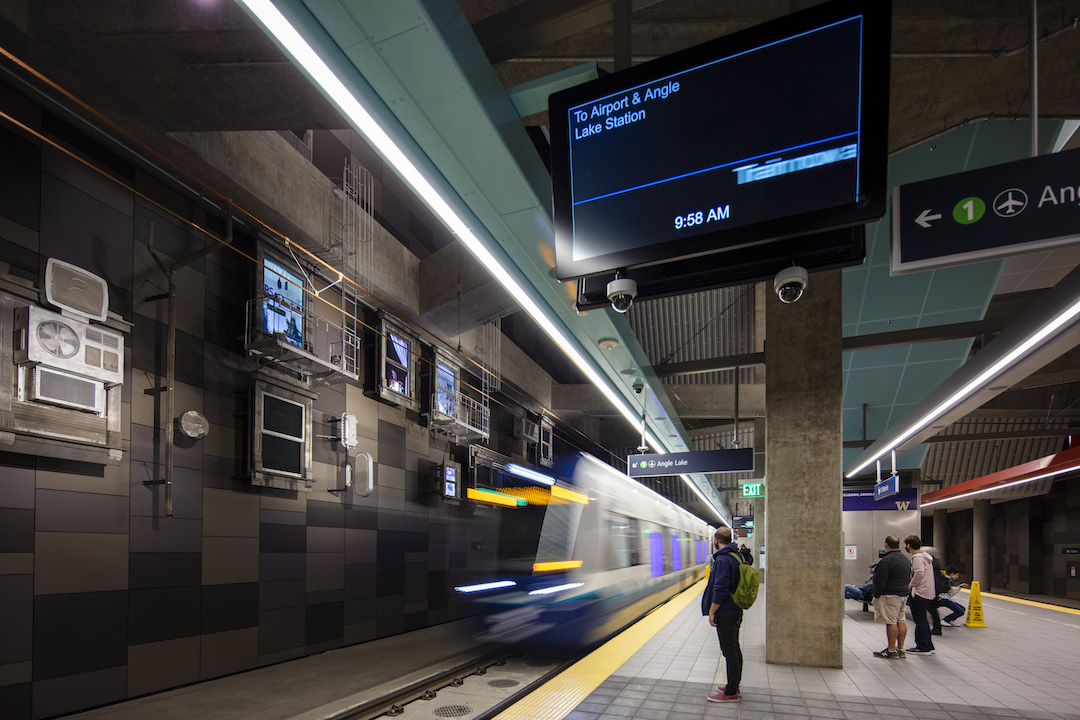The new 105,000-sf U District Station in Seattle has opened. The LMN Architects-designed project creates a unified transportation solution and offers a new gateway to the University of Washington campus.
The U District Station is a highly functional, easy-to-use, and appropriately scaled transit hub that is conveniently located for the diverse activities of daily commenting students, workers, and visitors. It is the first stop on the Northgate Link, a 4.3-mile light rail extension from the University of Washington Station on its way north.
The station’s train platform is located 85 feet below street level, with the bulk of the entire 105,000-sf area below grade. Each of the station’s two entrances provides elevators, escalators, and stairs to the trains below. The north entrance lobby serves riders heading to and from the adjacent Neptune Theater and mixed-use neighborhood, as well as a major Metro bus transfer hub on NE 45th Street. The south lobby gives pedestrians a direct link to the UW campus a few blocks east. The sidewalks and streets facing the entrances meet Green Street standards and feature ample landscaping, pedestrian lighting, seat walls, and a bike lane. Both entrance lobbies offer bicycle storage and racks.

From the north and south lobbies, commuters descend through the escalator and stair tubes to a mid-level open landing that is placed within a tall voluminous central space. From here, they can continue to the train platform below via open escalators and an open stair. The landing appears to float above the angled cross-bracing elements and is offset to the east. This offset, along with artwork and video installation on the west wall, create a design asymmetry that helps to define north-south way finding and directionality on the platform.
The large central volume is defined by a white corrugated metal ceiling and canted walls that conceal essential back-of-house functions. Wayfinding is enhanced by overhead aluminum tubes containing lighting, speakers, and other systems. Two different colors aid passengers in orienting north and south: orange for north and blue for south.
The completed project anticipates record numbers of riders as Seattle’s urban evolution continues.
Related Stories
| Dec 28, 2014
The future of airport terminal design: destination status, five-star amenities, stress-free travel
Taking a cue from the hospitality industry, airport executives are seeking to make their facilities feel more like destinations, writes HOK's Richard Gammon.
| Nov 18, 2014
New tool helps developers, contractors identify geographic risk for construction
The new interactive tool from Aon Risk Solutions provides real-time updates pertaining to the risk climate of municipalities across the U.S.
| Oct 16, 2014
Henning Larsen Architects to design train station for planned Danish town
Danish firm Henning Larsen Architects won Frederikssung municipality’s architecture competition for a regional train station in the planned city of Vinge—Denmark’s largest urban development.
| Oct 16, 2014
Perkins+Will white paper examines alternatives to flame retardant building materials
The white paper includes a list of 193 flame retardants, including 29 discovered in building and household products, 50 found in the indoor environment, and 33 in human blood, milk, and tissues.
| Oct 15, 2014
Harvard launches ‘design-centric’ center for green buildings and cities
The impetus behind Harvard's Center for Green Buildings and Cities is what the design school’s dean, Mohsen Mostafavi, describes as a “rapidly urbanizing global economy,” in which cities are building new structures “on a massive scale.”
| Oct 12, 2014
AIA 2030 commitment: Five years on, are we any closer to net-zero?
This year marks the fifth anniversary of the American Institute of Architects’ effort to have architecture firms voluntarily pledge net-zero energy design for all their buildings by 2030.
| Oct 3, 2014
New survey tracks Americans’ attitudes towards transit use
A record 10.7 billion rides were taken on public transit in the United States last year. And a national survey of Americans finds that the speed, reliability, and cost, more than any other factors, determine people’s willingness and frequency of use.
| Sep 24, 2014
Architecture billings see continued strength, led by institutional sector
On the heels of recording its strongest pace of growth since 2007, there continues to be an increasing level of demand for design services signaled in the latest Architecture Billings Index.
| Sep 22, 2014
4 keys to effective post-occupancy evaluations
Perkins+Will's Janice Barnes covers the four steps that designers should take to create POEs that provide design direction and measure design effectiveness.
| Sep 22, 2014
Sound selections: 12 great choices for ceilings and acoustical walls
From metal mesh panels to concealed-suspension ceilings, here's our roundup of the latest acoustical ceiling and wall products.
















